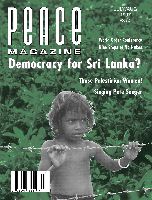
Peace Magazine Jul-Aug 1997, page 30. Some rights reserved.
Search for other articles by Natalie Lund here
Eleanor Coerr,Sadako, illustrated by Ed Young. G.P. Putnam's Sons, 1993.
Yukio Tsuchiya, Faithful Elephants, illustrated by Ted Lewin, translated by Tomoko Tsuchiya Dykes. Houghton Mifflin Co., 1988
Last summer I did a lot of thinking about peace. My church addresses my need for internal peace. My newspaper reminds me of the need for societal peace. And one Saturday morning not long ago, I had a peace epiphany while browsing at the local library.
I opened a large-format picture book and was drawn into the sad, touching story of Sadako, a Japanese child who developed "bomb sickness" following World War II. Young Sadako folded cranes from colored paper, believing that an offering of 1,000 such birds would cause the gods to grant her wish and make her well again.
There is no happy ending to this story. Sadako died, and her classmates finished making the cranes as a memorial to be buried with their young friend.
In time, the story of Sadako became widely known, and young people throughout Japan collected money to build a memorial in the Hiroshima Peace Park. Today, one can visit a statue of Sadako and see her holding a large golden crane in heaven-stretched hands. It has become a custom for people to place paper cranes at the memorial each year on August 6, Peace Day.
There were tears in my eyes and a lump in my throat as I sat reading in the children's section. I signed the book out knowing I needed to read it again and share it with friends.
After reading Sadako, I did some serious reflecting on life and war and peace. I marked "Peace Day" on the August 6 square on my appointment calendar. I called my local bookstore to order several copies of Sadako for upcoming birthday gifts. I memorized the words engraved in the Sadako statue, "This is our cry, this is our prayer; peace in the world."
The Sadako story reminds me that children's literature is powerful stuff, every bit as interesting and gripping and life-changing as literature aimed at grown-ups. The power of Sadako whets my appetite for more literary experiences of raw emotion, more stories that contain deep truth as well as fact.
My favorite companion literature to Sadako is Faithful Elephants by Yukio Tsuchiya. Continuously in print for the past 40 years, this book also looks at World War II Japan. And it also is a tragedy, describing how zoo animals were killed by army command to prevent the possibility of their escaping bomb-damaged zoos.
As the story unfolds, we learn that the killing of elephants in wartime Japan was no easy task. There were no guns available to shoot them; elephant hides were too thick to be penetrated by lethal injection; the animals refused food laced with poison. And so a decision was made to starve them to death.
"I can't believe this is for children," exclaimed a co-worker as she read these words: "The trainer could stand it no longer. 'Oh, Tonky! Oh, Wanly!' he wailed, and dashed to the food shed. He carried food and pails of water to them and threw it at their feet. 'Here!' he said, sobbing, and clung to their thin legs. 'Eat your food! Please drink. Drink your water!...Seeing his beloved elephants dying this way, the elephant trainer felt as if his heart would break."
But, of course, children do understand sadness, and good literature. They listen with their hearts as well as their minds. Deep down, they know that hope is rooted in reality, not wishful thinking. They are not afraid of dark topics; they return again and again to books that inspire morally and spiritually, that resonate in their souls.
And so, as Peace Day approaches, adults can sow and nurture the seeds of global peace, by sharing with children stories that whisper hope, ignite imagination, and grow into vision.
The anniversary of Japan's surrender in World War II is marked each year with a radio broadcast of the reading of Faithful Elephants. This is not a trivial act. Only when we fully realize the chaos and horror and foolishness of war will we do everything possible to build and maintain true and lasting peace.
Reviewed by Natalie Lund, a peace activist based in Glasgow, Kentucky.

Peace Magazine Jul-Aug 1997, page 30. Some rights reserved.
Search for other articles by Natalie Lund here